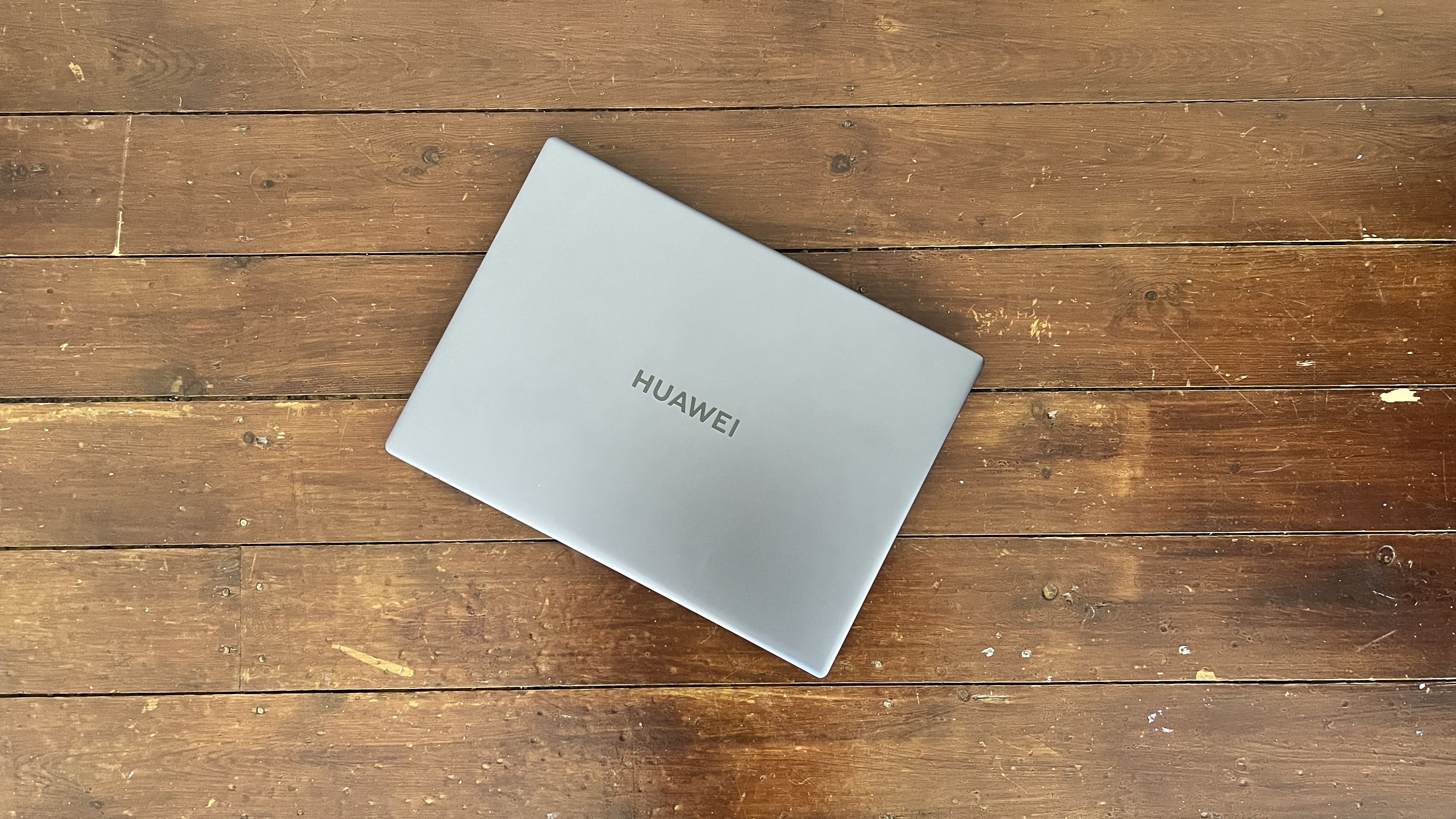Laptop Mag Verdict
The Huawei MateBook 16s is one of the best big screen Windows laptops you can buy today — sporting a beautiful display, a great keyboard and touchpad, and powerful 12th Gen Intel performance in a sleek chassis. I would love to see a dedicated GPU configuration for creative pros and maybe a number pad-featured alternative, to speed up data entry in the future.
Pros
- +
Drop-dead gorgeous display
- +
Impressive speakers
- +
Powerful 12th Gen Intel performance
- +
Strong battery life
- +
Value for money
Cons
- -
Middling webcam
- -
No dedicated GPU options
- -
No number pad
- -
Quite a heavy machine
Why you can trust Laptop Mag
Sometimes, size does matter and the Huawei MateBook 16s proves that by just being a really good big-screen laptop for most use cases.
What do I mean by that? Well, just look at it — the gorgeous 3:2 aspect ratio 16-inch display, the 12th Gen Intel performance, impressive thermal management, and strong battery life all come together with a massive touchpad and tactile keyboard for a system that is a joy to work on.
It’s not perfect. I may have been a little too keen in saying that this could take on the MacBook Pro, but we’ll address that by answering one simple question: is the MateBook 16s worth it for you?
Huawei MateBook 16s price and availability
Price: £1,299 / £1,499
CPU: Intel Core i7-12700H / i9-12900H
RAM: 16GB
Storage: 1TB
Display: 16-inch, 2520 x 1680-pixel resolution
Size: 13.8 x 9.9 x 0.7 inches
Weight: 4.4 pounds
I’ll rip off the bandaid immediately and say sorry, America. You’re not getting the MateBook 16s outside of getting it imported. Huawei’s relationship with the U.S. is still in a strange territory, meaning laptops and phones won’t officially launch in the region.
Elsewhere, you can pick up the Huawei MateBook 16s in two flavors: a 12th Gen Intel Core i7 model (the one we tested) for £1,299/€1,699, or an Intel Core i9 model for £1,499/€1.899.
It’s weird to find competition for the MateBook 16s, as it is priced smack-bang in the middle of the two polar extremes you find in the 16-inch laptop category — £1,100 less than the lowest specced 16-inch M1 Pro MacBook Pro, but £550 more expensive than the Huawei MateBook D16. I’ll compare it to these two to give you an idea of where this stacks up between these two extremes.
Huawei MateBook 16s design

From every angle, the Huawei MateBook 16s is quite the looker — sporting an unmistakably premium, CNC milled and sandblasted metallic body in a stylish Space Grey finish. It makes for a smooth finish that welcomes your fingers with each caress across both the shell and the keyboard deck, which has plenty of space for your wrists to rest while you type.
Sign up to receive The Snapshot, a free special dispatch from Laptop Mag, in your inbox.
Of course, portability is always going to be a challenge with a laptop this big, which Huawei combats with a svelte shell that comes in at 13.8 x 9.9 x 0.7 inches, but a hefty weight of 4.4 pounds. For context, this is slightly smaller and lighter than the 16-inch MacBook Pro (14 x 9.7 x 0.7 inches, 4.8 pounds), while being smaller but heavier than the MateBook D16 (14 x 9.8 x 0.7 inches, 3.7 pounds).

Looking past the numbers, this all adds up to a respectably sleek (if heavy) system to carry around in one of the best laptop backpacks, and one you won’t be embarrassed to whip out at meetings.
Huawei MateBook 16s ports
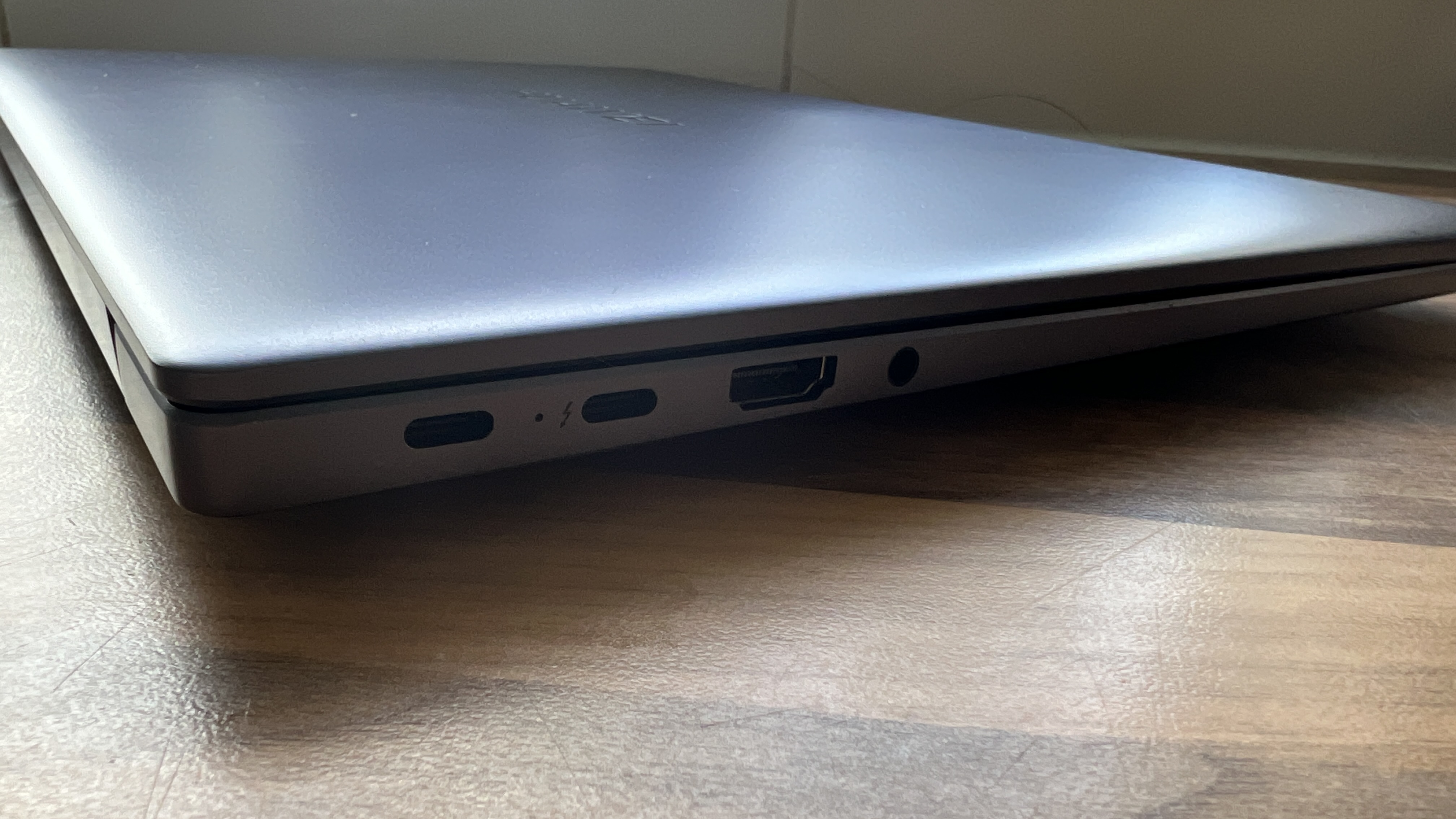
The port array is nicely varied on the Huawei MateBook 16s, but not quite the full suite I would have loved to see.
On the left, you will find two USB-C ports (one of them with Thunderbolt 4 support), a 3.5mm headphone jack and full-size HDMI 2.0.On the right, there are two USB-A 3.2 Gen 1 ports.
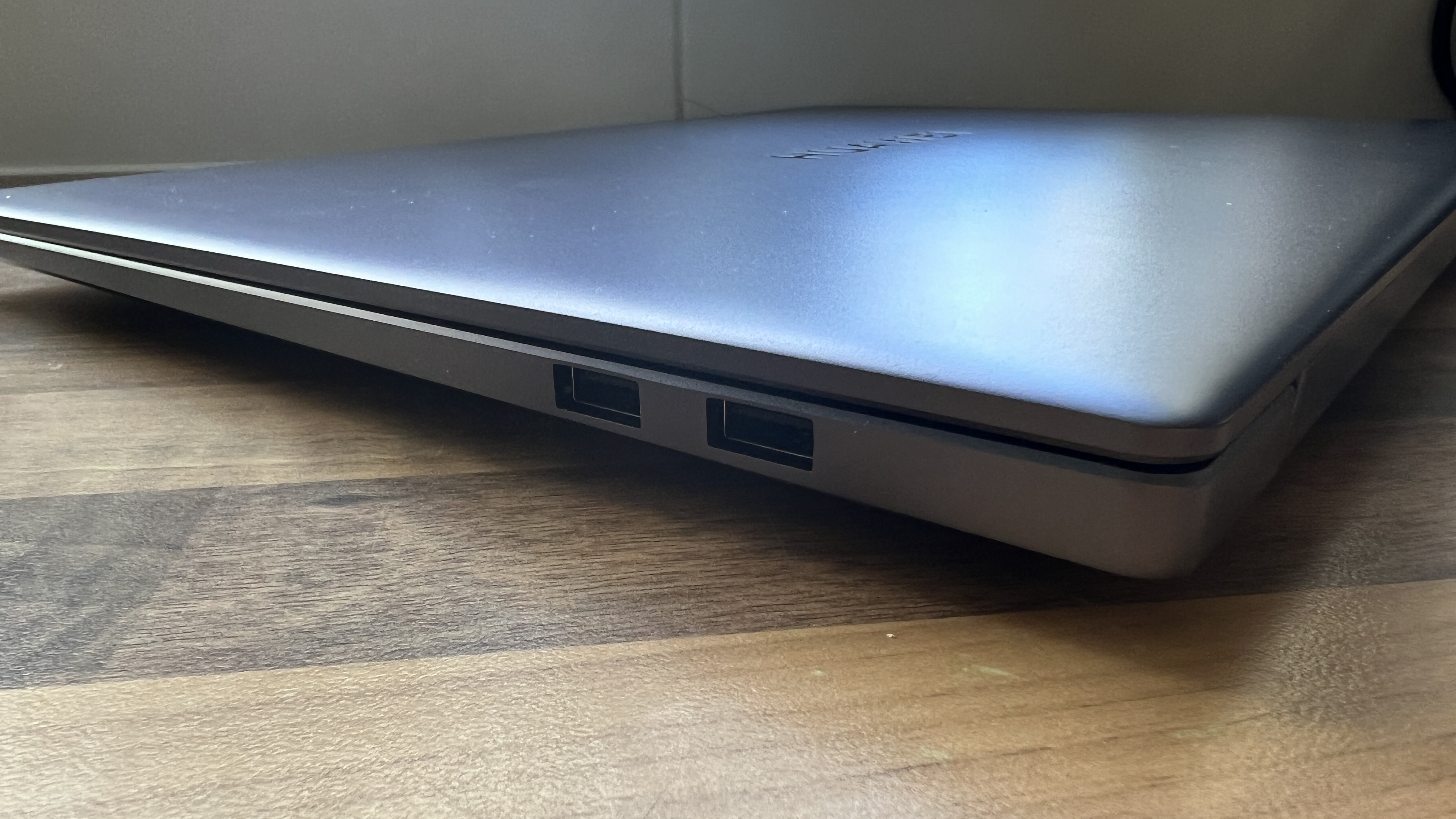
This means you can plug in a whole lot of peripherals, but on a system this big, I would have expected a little more versatility, maybe an SD card slot and Gigabit Ethernet.
Huawei MateBook 16s display
Displays are so thoroughly inconsistent across big-screen laptops, with some pricier options packing the gorgeous panels they deserve, but other cheaper models compromising in this area. I’m happy to report that the MateBook 16s lurches to the former — this is a stunner.
Details are super crisp on this 16-inch IPS display with a 2520 x 1680-pixel resolution, a 3:2 aspect ratio (great for seeing more content while working), and a 90% screen-to-body ratio. Plus, for direct contact with your work, the ten-point multitouch screen is latency free and moves swiftly with every interaction.
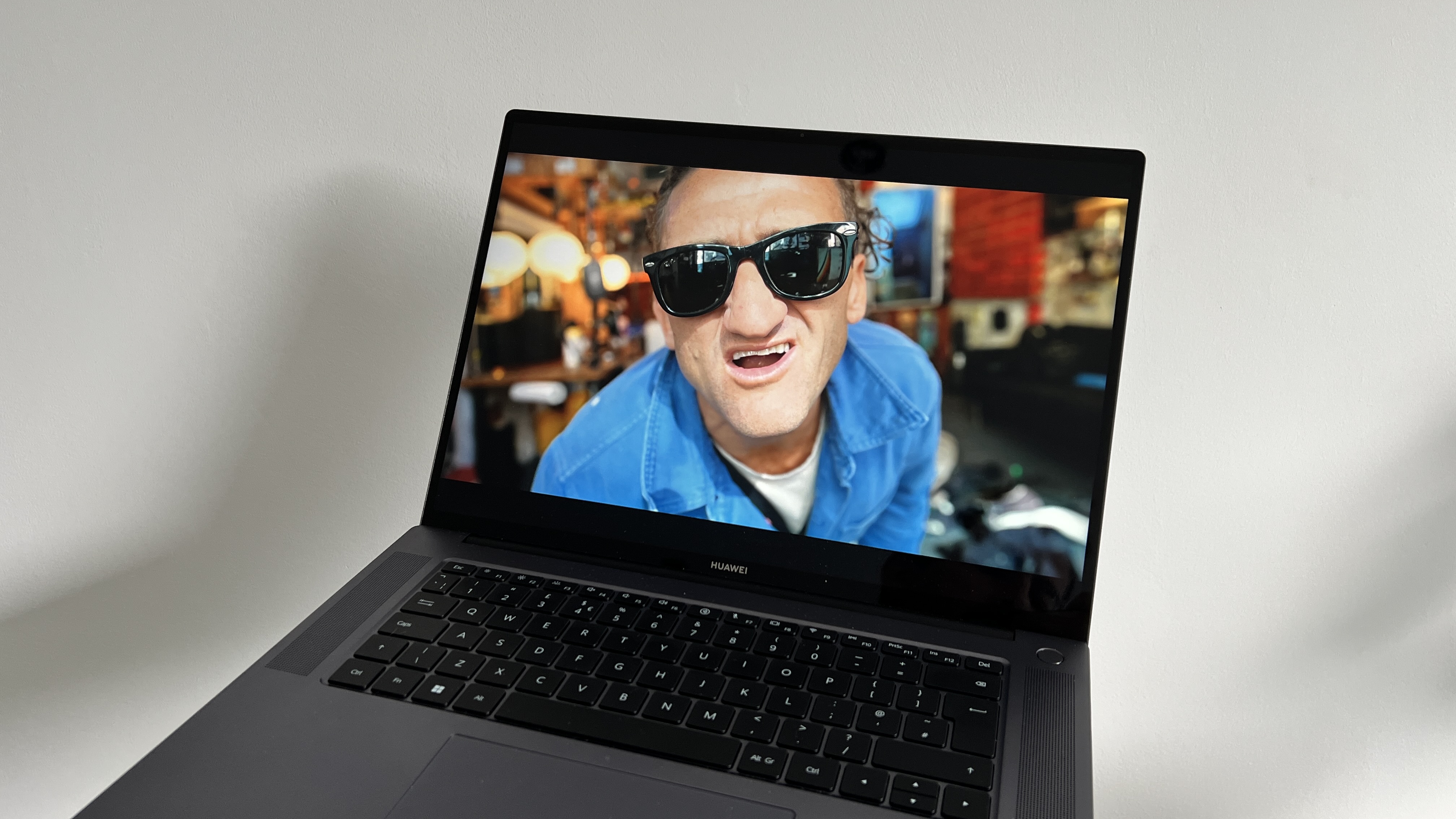
As for brightness and versatility of highlights and low darks, Huawei claims a 300-nit maximum brightness and 1500:1 contrast ratio, which translates to a screen that can get bright enough for working in some challengingly bright lighting conditions.However, the glossy glass surface of the display creates some distracting reflections that can overwhelm max brightness when used outdoors.
Looking at the contrast and color, these add up to a vividness that pops off the screen and an impressive depth to the darker tones that makes brighter moments shine in shows like Obi-Wan Kenobi. More importantly, this also means color accuracy that makes creative applications such as Photoshop a joy to use on a massive screen like this.
Plus, with TÜV Rheinland Low Blue Light and Flicker Free certification, you can work late into the night with confidence that your eyes are being looked after.
Huawei MateBook 16s keyboard and touchpad

You’re going to have a good time clicking and typing on the Huawei MateBook 16s, as the touchpad is ginormous and the keyboard is full-size with a lovely tactile feel to every press.
The chiclet keyboard that sports a nice, even backlighting across each key. The scissor switches give you 1.5mm of travel with a soft landing design (basically a cushion that braces the impact of every key press). And while the up and down arrow keys are sandwiched and the enter key is half-height, letter and number keys are generously large and typing is an all-round joy.
I tested this using the 10FastFingers.com typing assessment and I hit a decent 86 words per minute. For context, I normally hit 83-85 wpm on a laptop keyboard, which emphasizes how ergonomically sound this board is. I didn’t go as fast as the MateBook X Pro, but that comes down to the keyboard being a little marooned in the middle of this large base — something that I’m not entirely used to with a life dedicated to smaller laptops like my daily driver, the M1 MacBook Pro.

This comes paired with (as you’d expect on a 16-inch laptop) a massive touchpad — measuring in at 5.7 x 3.6 inches, which is slightly smaller than the MacBook Pro (6.3 x 3.9 inches), but does feel impressively spacious.
After using (and loving) the edge controls on the MateBook X Pro, I was a little disappointed to not see these make an appearance on the 16s, along with the lack of a solid state construction. But make no mistake, this touchpad is smooth, while clicks, taps, and multi-touch gestures are nice and responsive.
Huawei MateBook 16s audio

As you’d expect from a 16-inch laptop with no number pad, Huawei has plenty of room to pack some big speakers in here — big dual front-facing surround-sound speakers, to be specific.
Much like the MateBook X Pro, they provide an impressive level of detail to the highs and mids, while delivering a decent oomph to the lows for a warm audio production with clarity. The soaring vocals in Four Year Strong’s cover of “Bittersweet Symphony” shine nicely above the detailed crunch of the distorted guitars, the deep ferocity of the drum kit, and the satisfying bass kick.
Whatever you’re listening to and whatever circumstances you need to listen (thanks to the 3.5mm headphone jack), this is a nice-sounding system.
Huawei MateBook 16s performance
Under the hood, Huawei has given this the beans with an Intel Core i7-12700H processor in the MateBook 16s we tested, alongside 16GB of LPDDR5 RAM and a 1TB NVMe PCIe SSD. You can max this out with an Core i9-12900H CPU — both of which rely on Iris Xe integrated graphics .
I put this through the usual high-pressure rigmarole — Two Point Campus running in the background as I edited a massive RAW picture in Photoshop, played multiple 1080p YouTube videos, streamed on Twitch with OBS and ran a benchmark. But even under such stress, touch responsiveness didn’t lag and the system kept running smoothly.
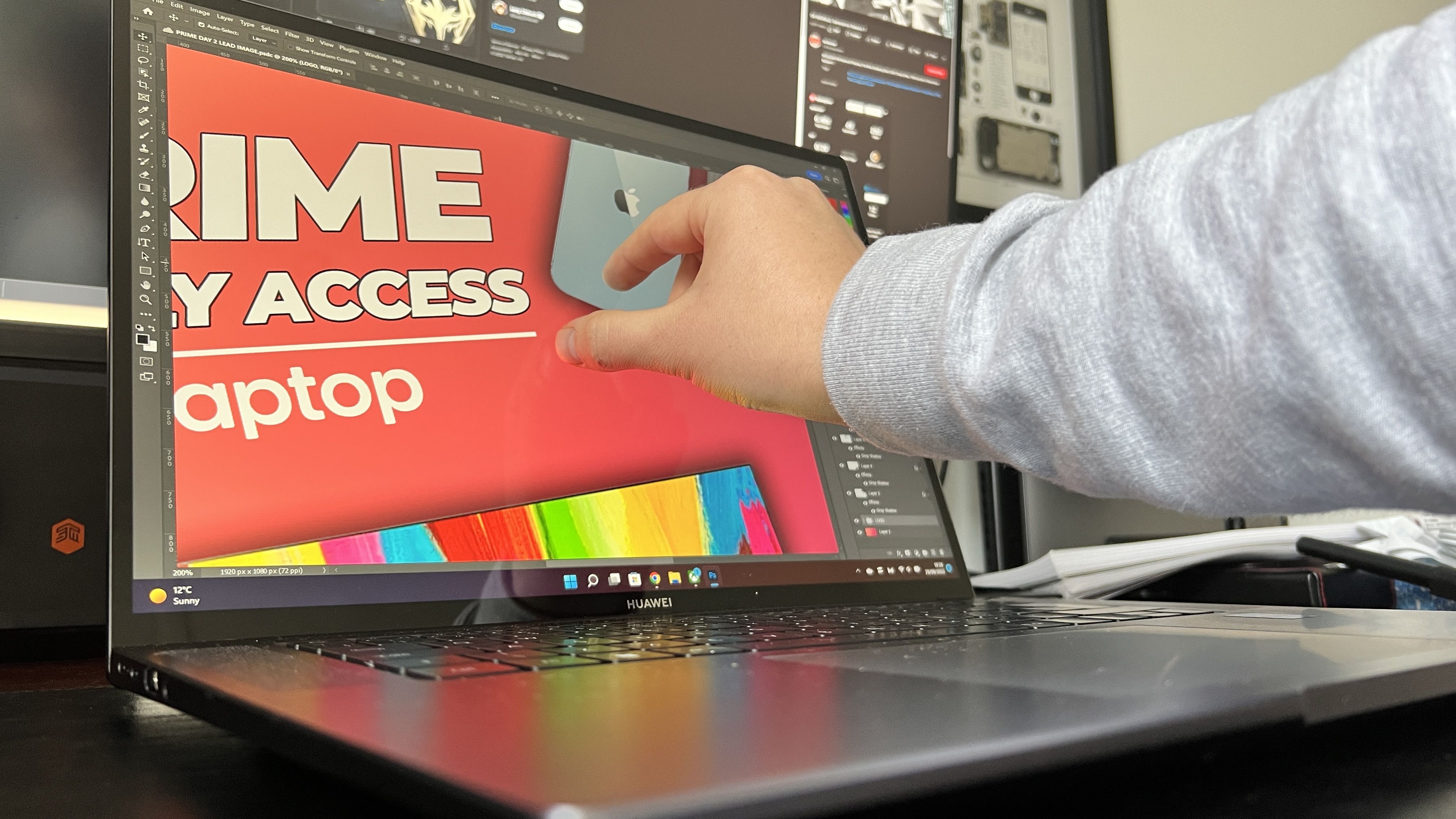
When put through our testing, the CPU hit a Geekbench 5.4 multi-core score of 9,337, which is virtually identical to the same-specced MateBook D16 (9,370), but is obliterated by the MacBook Pro (12,147). However, it beats our premium laptop average (5,956).
In Handbrake app benchmark testing, we saw the MateBook 16s convert a 4K video to 1080p in 7 minutes and 45 seconds — nowhere near the MacBook Pro (4:47), but well ahead of the category average (13:27).
And finally, if you are moving high-capacity files around, the M.2 SSD has a blistering sequential speed of 1,323 MBps, which handily defeats the industry average (825 MBps) but drops behind the MacBook Pro’s ludicrous 5,321.5 MBps.
Huawei MateBook 16s graphics
It comes as no surprise the MateBook 16s is not a laptop that’s been built for gaming. That said, the integrated graphics are a lot better than you might expext.
When we put the laptop through its 3DMark paces, we saw it handle Fire Strike with a score of 5,562, which falls short of the 9,020 average, formed by laptops far more expensive than this. But in reality, this translates to some solid performance across titles you would (and wouldn’t) expect.
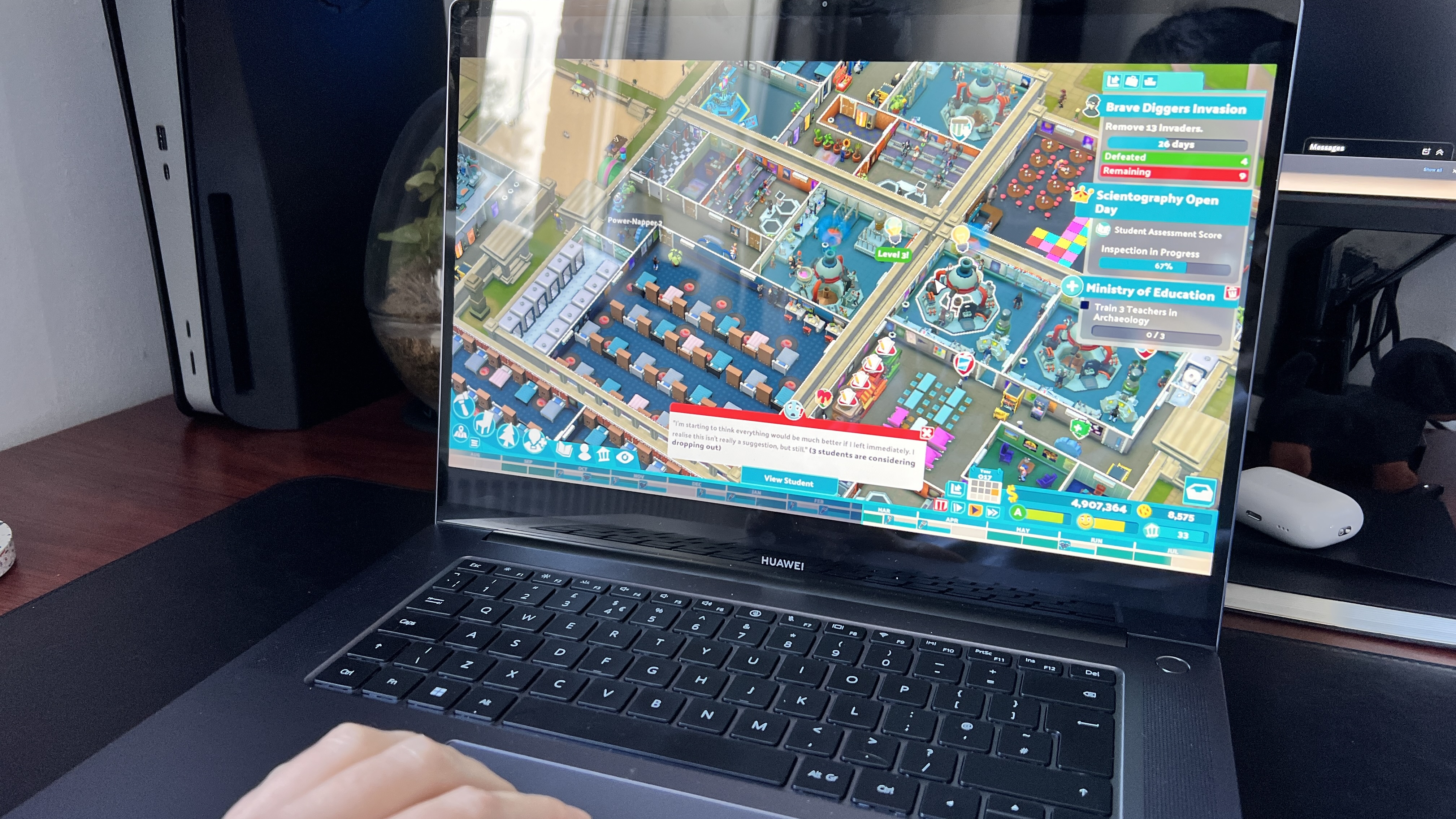
For example, you can get a rock solid 60 frames per second with no dips on Two Point Campus and F1 Manager 2022 with graphics turned down to medium. However, if you did want to delve a little deeper into the Xbox Game Pass for PC library, Forza Horizon 5 can run at 50 fps, provided you crank those settings down to low.
Like I said, this isn’t for gaming, but it is up to the job in a smaller sense. Outside of gaming, however, the graphical capabilities are pretty impressive. THe MateBook 16s is able to edit a couple of 4K video streams and do some high-resolution RAW photo tweaks without slowdown.
Huawei MateBook 16s battery life
And now, for one of the MateBook 16s’ super powers — the surprisingly strong battery life. Don’t get me wrong, it’s no MacBook Pro, but the stamina is impressive when you take a look at this in comparison to other Windows laptops with similar specs. Since we haven’t put this through the scientific rigmarole of our Battery Informant testing, I’ll just give you a diary of my day and when the 16s finally gave up the ghost.
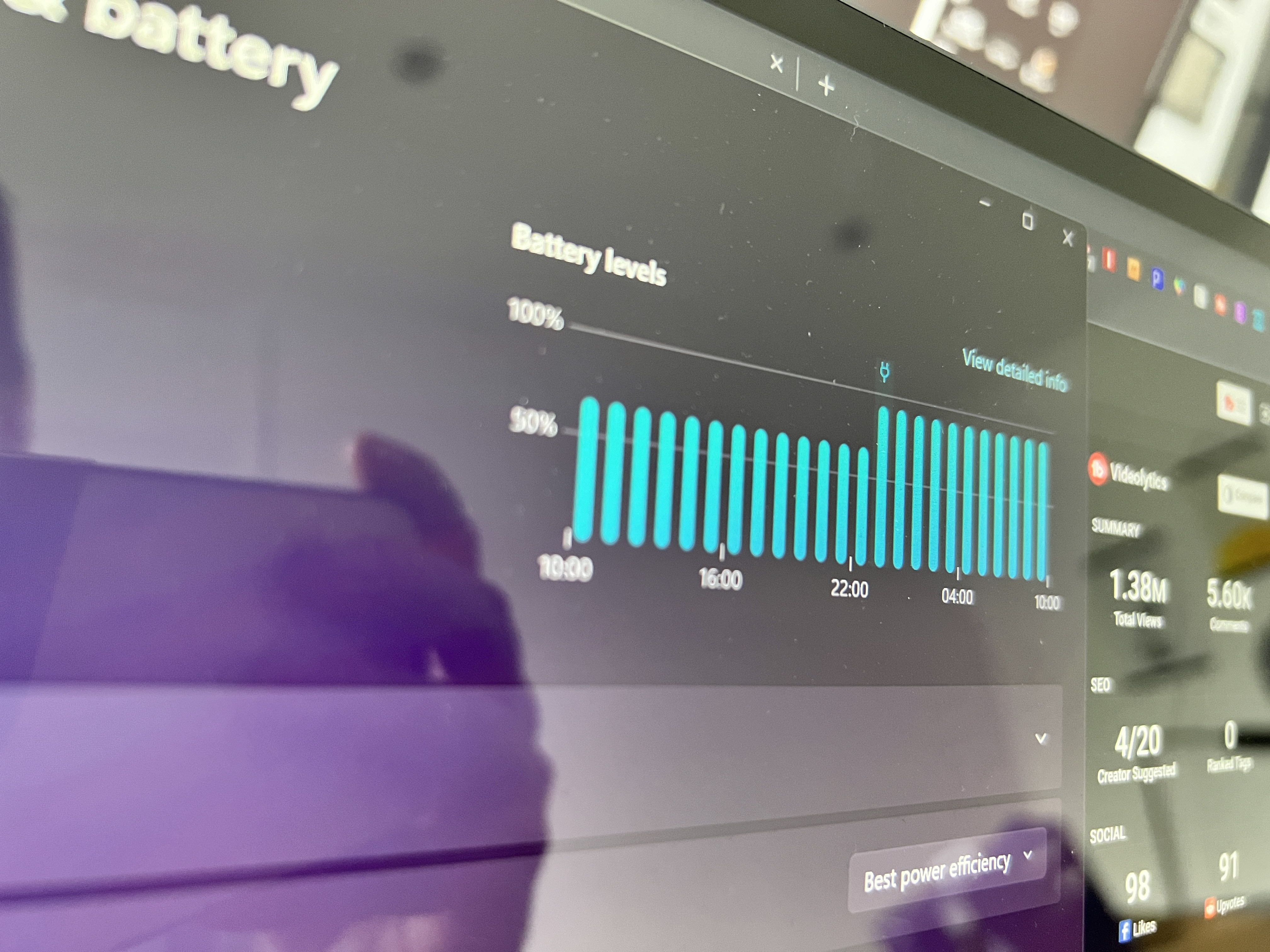
My day involves multiple Chrome tabs, Spotify and Slack running constantly, the occasional use of Photoshop, and some casual gaming on my lunch break (Uno is my current addiction). Starting at 9 a.m., I went all the way through the day to 6 p.m. before needing to charge. If you’re economical with power, you could realistically go all day without needing to worry about charging it.
This is all thanks to a beasty 84Wh battery, which can be charged up really quickly with the included 135W charger — an additional 3 hours from just a 15-minute charge, in fact!
Huawei MateBook 16s webcam
One thing I can say for sure is that the 1080p webcam in here is miles ahead of what you get in the Huawei MateBook X Pro, but the MateBook 16s is still a little fuzzy.

Detail is a lot better here, especially in well-lit conditions where the contrast starts to shine. But the aperture is still far too narrow for low light situations, where photos will still look pretty fuzzy.
Unfortunately, there is no Windows Hello support, as there is no IR camera. But the fingerprint reader softens that blow somewhat. If you do need better picture quality, you will always need to pick up an external webcam for the best possible capture.
Huawei MateBook 16s heat
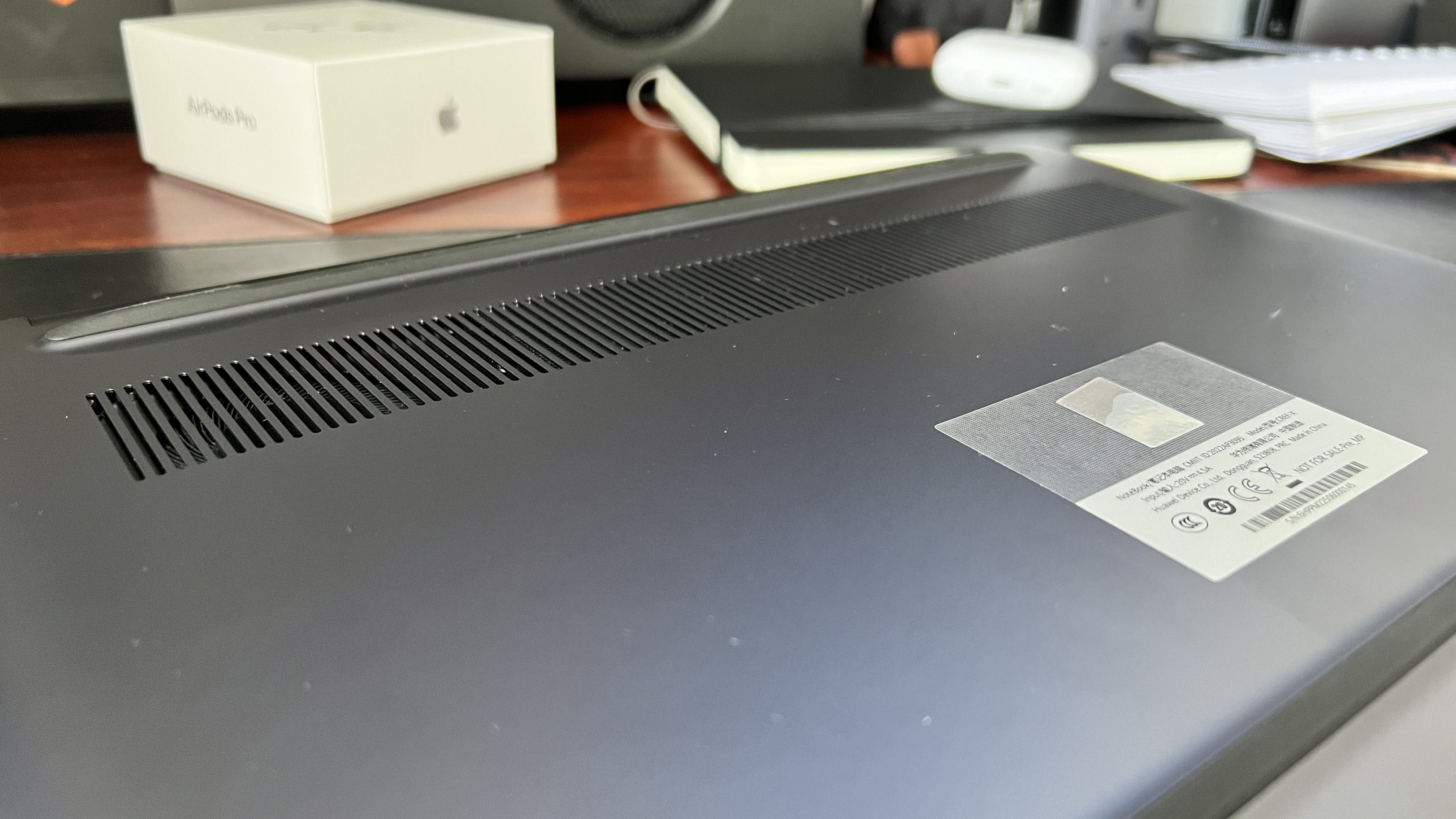
We can’t give exact temperatures across different areas of the MateBook 16s, as this system hasn’t gone through our rigorous lab testing. However, I can give you my own experience over the past few weeks of using this laptop and I can assure you that Huawei keeps things nice and cool.
The 75mm dual Shark Fin Fans work hard to draw cool air in, while the massive dual heatpipes dissipate any high temperatures with ease. Not a single part felt hot to the touch and, even more impressively, fans were whisper quiet in high-stress moments of multitasking.
Huawei MateBook 16s software and warranty
Huawei packs only one vital piece of software in the MateBook X Pro 2022 and it’s aptly called PC Manager. This lets you update any missing drivers on your PC or run checkups to ensure your hardware components are healthy. Surprisingly, there’s no Windows 10 bloatware installed on this device.
Since this product isn’t available in the U.S. yet, the warranty hasn’t been stated, but Huawei PC devices typically come with one-year limited warranties in the States.
Bottom line
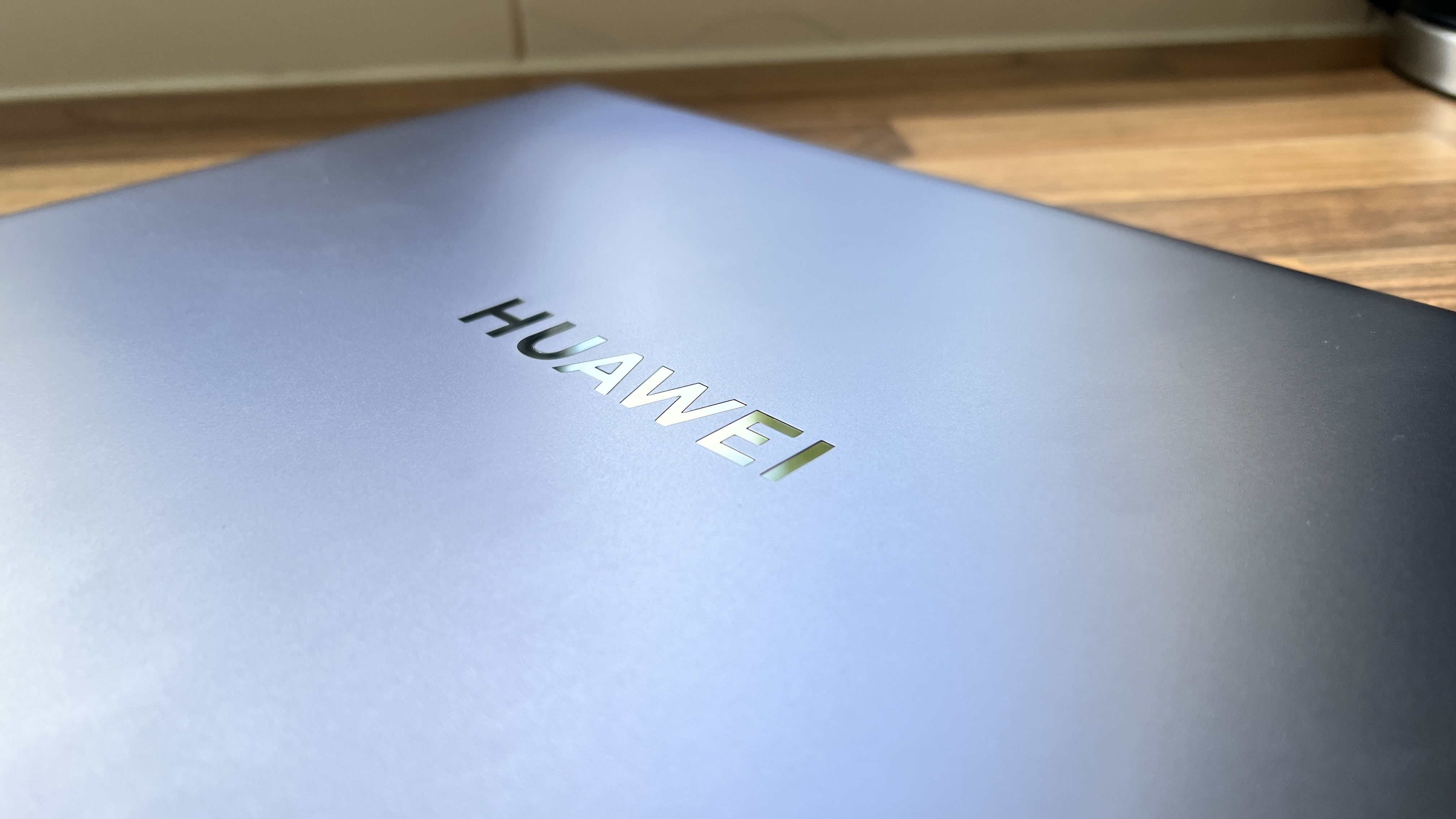
The Huawei MateBook 16s doesn’t have any frills, gimmicks, or special features. It is simply just one of the best 16-inch laptops you can buy today — a gorgeous display, powerful internals, great keyboard, sizable touchpad, and beasty internals that are packed into a stylish utilitarian frame.
It’s not perfect, thanks to a couple of omissions that limit its usability to particular niches, such as no discrete GPU configuration for creative work or gaming, and omitting a number pad for data entry.
But these minor concerns pale in comparison to what is an overwhelmingly strong, big-screen system with plenty of premium goodness with good value for money.

Jason brought a decade of tech and gaming journalism experience to his role as a writer at Laptop Mag, and he is now the Managing Editor of Computing at Tom's Guide. He takes a particular interest in writing articles and creating videos about laptops, headphones and games. He has previously written for Kotaku, Stuff and BBC Science Focus. In his spare time, you'll find Jason looking for good dogs to pet or thinking about eating pizza if he isn't already.
